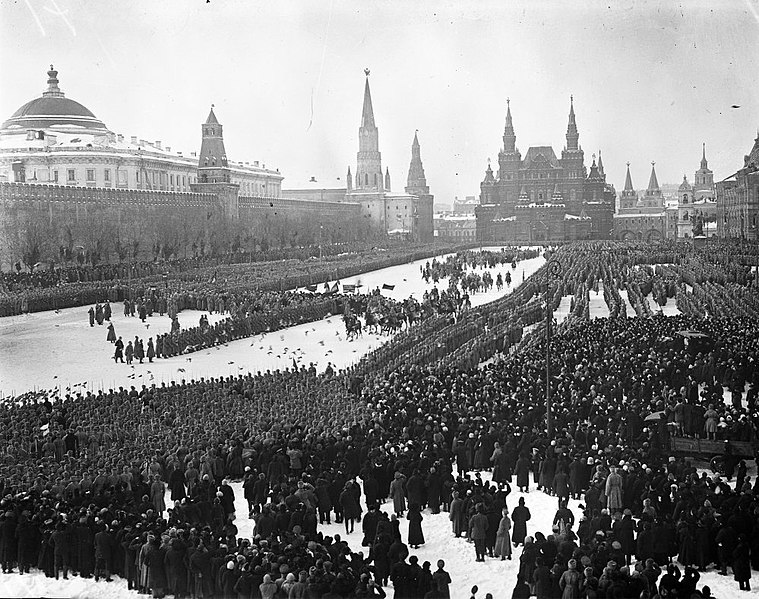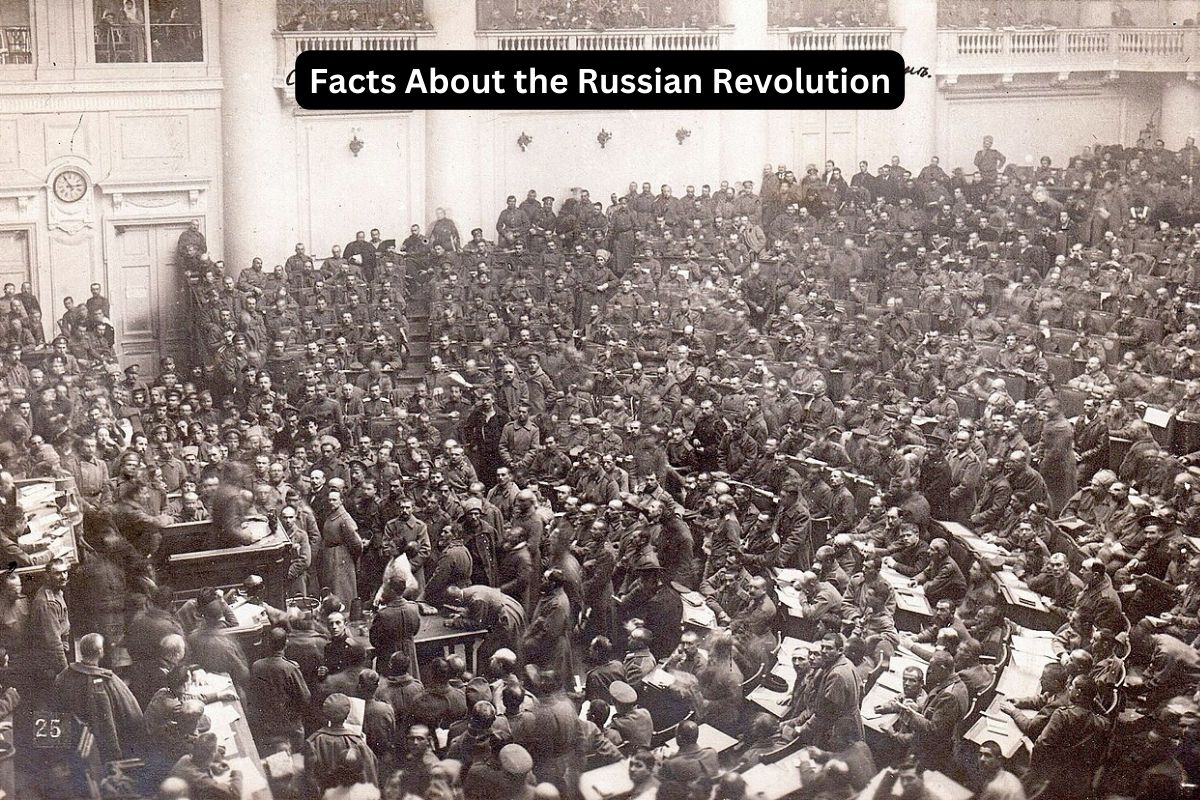The Russian Revolution of 1917 remains one of the 20th century’s most defining moments, reshaping global history profoundly.
From the February and October Revolutions to the birth of the world’s first socialist state, led by figures like Vladimir Lenin, the revolution marked the end of Tsarist autocracy amidst economic hardship and political turmoil.
This article explores its causes, key events, and lasting impact on the modern world, offering insight into its significance.
Russian Revolution Facts
1. Two major revolutions in 1917: February and October
The February Revolution began on February 23 (March 8 in the Gregorian calendar) with widespread demonstrations and strikes in Petrograd (now St. Petersburg) due to bread shortages, high casualties in World War I, and dissatisfaction with Tsar Nicholas II’s autocratic rule.
Also Read: Timeline of Russian Revolution
This led to the abdication of Tsar Nicholas II on March 15 (March 2 in the Julian calendar), ending centuries of Romanov rule and resulting in the establishment of a provisional government.
The October Revolution occurred on October 25 (November 7 in the Gregorian calendar) when the Bolsheviks, led by Vladimir Lenin, seized key government buildings in Petrograd, overthrowing the provisional government and establishing Soviet rule.

2. Causes: Economic hardship, social inequality, and dissatisfaction with Tsarist rule
Russia’s participation in World War I led to severe economic strain, food shortages, and discontent among soldiers and civilians alike.
The majority of Russians lived in poverty while a small elite controlled most of the wealth and land. The peasantry endured oppressive conditions, and urban workers faced harsh working conditions and low wages.
Dissatisfaction with the autocratic rule of the Tsar, who resisted calls for political reform, exacerbated social tensions and fueled revolutionary sentiments.
3. Bolshevik Party, led by Lenin, orchestrated the October Revolution
The Bolshevik Party, formed by Vladimir Lenin in 1903, was a faction of the Russian Social Democratic Labour Party advocating for a revolutionary overthrow of the capitalist system.
Also Read: Romanovs Timeline
Lenin’s leadership and ideology, which combined Marxist principles with a revolutionary vanguard party, played a crucial role in organizing the Bolsheviks and mobilizing support for the October Revolution.
The Bolsheviks capitalized on popular discontent, particularly among urban workers and soldiers, by promising an end to the war, land redistribution, and power to the soviets (councils) of workers, soldiers, and peasants.
4. End of Tsarist rule and establishment of a provisional government
The abdication of Tsar Nicholas II marked the end of the Romanov dynasty, which had ruled Russia for over three centuries.
Following the February Revolution, a provisional government composed of liberal and moderate socialist factions was established, headed by figures like Alexander Kerensky.
The provisional government initially enjoyed popular support, but it struggled to address the country’s deep-seated issues, including the continuation of World War I and land reform.

5. Formation of the Soviet Union in 1922
The Soviet Union, officially known as the Union of Soviet Socialist Republics (USSR), was established on December 30, 1922, consolidating the Bolshevik government’s control over various territories that had been part of the Russian Empire.
The USSR initially comprised Russia, Ukraine, Belarus, and the Transcaucasian Federation (later divided into the Georgian, Armenian, and Azerbaijani SSRs). It expanded over time to include other republics.
The Soviet Union became the world’s first socialist state, governed by the principles of Marxism-Leninism, with a centrally planned economy and a single-party system dominated by the Communist Party.
6. Civil War between Bolsheviks (Reds) and opponents (White Army)
The Russian Civil War erupted in 1917–1918 following the Bolshevik seizure of power, pitting the Bolsheviks, or Reds, against a diverse array of opponents, collectively known as the White Army.
The White Army consisted of various groups, including monarchists, liberals, conservatives, nationalists, and anti-Bolshevik socialists, united by their opposition to Bolshevik rule.
The Civil War was characterized by brutal fighting, atrocities, and foreign intervention, with major powers such as Britain, France, Japan, and the United States supporting the White Army in hopes of reversing the Bolshevik victory.
Despite facing significant challenges, the Bolsheviks ultimately emerged victorious, consolidating their control over the territories of the former Russian Empire and solidifying their rule over the newly formed Soviet Union.
7. Execution of Tsar Nicholas II and his family
Following the Bolshevik takeover in 1917, Tsar Nicholas II and his family were initially placed under house arrest in the Siberian city of Tobolsk.
In 1918, amidst the escalating violence of the Civil War and fears that the royal family might become a rallying point for counter-revolutionary forces, the Bolsheviks decided to move them to Yekaterinburg.
On the night of July 16-17, 1918, Tsar Nicholas II, his wife Alexandra, their five children, and a few loyal servants were executed by Bolshevik guards in the basement of the Ipatiev House, where they were being held.
The execution of the Romanovs symbolized the definitive end of the old regime and further fueled the violence and animosity of the ongoing Civil War.

8. Implementation of War Communism and later the New Economic Policy (NEP)
War Communism was the Bolsheviks’ economic policy implemented during the Civil War, characterized by the nationalization of industry, strict state control over food production and distribution, and the requisitioning of grain from peasants to feed the urban population and the Red Army.
War Communism resulted in widespread economic dislocation, famine, and social unrest, as well as resistance from peasants and workers.
In 1921, facing the dire consequences of War Communism, Lenin introduced the New Economic Policy (NEP), which allowed for some elements of capitalism to revive the economy.
Under the NEP, small-scale private enterprise was permitted, peasants were allowed to sell their surplus produce on the open market, and foreign trade was encouraged. This led to a period of relative stability and economic recovery.
9. Lasting global impact on politics, ideology, and society
The Russian Revolution had a profound and enduring impact on global politics, inspiring socialist and communist movements worldwide.
It led to the establishment of socialist states in several countries, including the Soviet Union and its satellite states in Eastern Europe, as well as communist regimes in Asia, Africa, and Latin America.
The revolution also shaped the ideological and geopolitical dynamics of the 20th century, contributing to the rise of the Cold War between the Western capitalist bloc led by the United States and the Eastern bloc led by the Soviet Union.
10. Shaped the course of the 20th century, influencing the Cold War and geopolitics
The Russian Revolution and the subsequent establishment of the Soviet Union transformed the global balance of power, leading to decades of ideological confrontation and geopolitical rivalry between the communist East and the capitalist West.
The Cold War, which lasted from the late 1940s to the early 1990s, was characterized by intense competition between the United States and its allies and the Soviet Union and its allies in political, economic, military, and ideological spheres.
The aftermath of the Russian Revolution also influenced the decolonization movement, nationalist struggles, and revolutionary movements in various parts of the world, shaping the course of international relations and world history throughout the 20th century.
